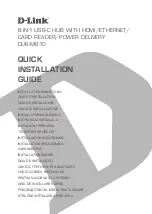
– 560 –
C
HAPTER
21
| Unicast Routing
Configuring the Open Shortest Path First Protocol (Version 2)
◆
IP Address
– Address of the interfaces assigned to a VLAN on the
Network Area (Add) page.
This parameter only applies to the Configure by Address page.
◆
Cost
– Sets the cost of sending a protocol packet on an interface,
where higher values indicate slower ports. (Range: 1-65535;
Default: 1)
The interface cost indicates the overhead required to send packets
across a certain interface. This is advertised as the link cost in router
link state advertisements.
Routes are assigned a metric equal to the sum of all metrics for each
interface link in the route.
This router uses a default cost of 1 for all ports. Therefore, if you install
a 10 Gigabit module, you need to reset the cost for all of the 1 Gbps
ports to a value greater than 1 to reflect the actual interface bandwidth.
◆
Router Priority
– Sets the interface priority for this router.
(Range: 0-255; Default: 1)
This priority determines the designated router (DR) and backup
designated router (BDR) for each OSPF area. The DR forms an active
adjacency to all other routers in the area to exchange routing topology
information. If for any reason the DR fails, the BDR takes over this role.
Set the priority to zero to prevent a router from being elected as a DR
or BDR. If set to any value other than zero, the router with the highest
priority becomes the DR and the router with the next highest priority
becomes the BDR. If two or more routers are set to the same highest
priority, the router with the higher ID will be elected.
If a DR already exists for an area when this interface comes up, the
new router will accept the current DR regardless of its own priority. The
DR will not change until the next time the election process is initiated.
Configure router priority for multi-access networks only and not for
point-to-point networks.
◆
Hello Interval
– Sets the interval between sending hello packets on an
interface. This interval must be set to the same value for all routers on
the network. (Range: 1-65535 seconds; Default: 10)
Hello packets are used to inform other routers that the sending router
is still active. Setting the hello interval to a smaller value can reduce
the delay in detecting topological changes, but will increase routing
traffic.
◆
Dead Interval
– Sets the interval at which hello packets are not seen
before neighbors declare the router down. This interval must be set to
the same value for all routers on the network. (Range: 1-65535
seconds; Default: 40, or 4 times the Hello Interval)
The dead-interval is advertised in the router's hello packets. It must be
a multiple of hello-interval and be the same for all routers on a specific
network.
Summary of Contents for LGB6026A
Page 6: ...ABOUT THIS GUIDE 4...
Page 40: ...38 CONTENTS...
Page 60: ...58 SECTION I Getting Started...
Page 86: ...84 SECTION II Web Configuration Unicast Routing on page 517 Multicast Routing on page 575...
Page 162: ...160 CHAPTER 5 Interface Configuration VLAN Trunking...
Page 196: ...194 CHAPTER 6 VLAN Configuration Configuring MAC based VLANs...
Page 204: ...CHAPTER 7 Address Table Settings Clearing the Dynamic Address Table 202...
Page 238: ...CHAPTER 11 Class of Service Layer 2 Queue Settings 236...
Page 254: ...252 CHAPTER 12 Quality of Service Attaching a Policy Map to a Port...
Page 448: ...446 CHAPTER 16 Multicast Filtering Multicast VLAN Registration...
Page 470: ...468 CHAPTER 17 IP Configuration Setting the Switch s IP Address IP Version 6...
Page 576: ...574 CHAPTER 21 Unicast Routing Configuring the Open Shortest Path First Protocol Version 2...
Page 606: ...604 CHAPTER 22 Multicast Routing Configuring PIMv6 for IPv6...
Page 620: ...618 CHAPTER 23 Using the Command Line Interface CLI Command Groups...
Page 672: ...670 CHAPTER 25 System Management Commands Time Range...
Page 692: ...690 CHAPTER 26 SNMP Commands...
Page 700: ...698 CHAPTER 27 Remote Monitoring Commands...
Page 854: ...CHAPTER 34 Port Mirroring Commands Local Port Mirroring Commands 852...
Page 862: ...860 CHAPTER 36 Address Table Commands...
Page 958: ...956 CHAPTER 40 Quality of Service Commands...
Page 1034: ...1032 CHAPTER 42 LLDP Commands...
Page 1044: ...1042 CHAPTER 43 Domain Name Service Commands...
Page 1062: ...1060 CHAPTER 44 DHCP Commands DHCP Server...
Page 1206: ...CHAPTER 47 IP Routing Commands Open Shortest Path First OSPFv3 1204...
Page 1250: ...1248 SECTION IV Appendices...
Page 1256: ...1254 APPENDIX A Software Specifications Management Information Bases...
Page 1278: ...1276 COMMAND LIST...
















































